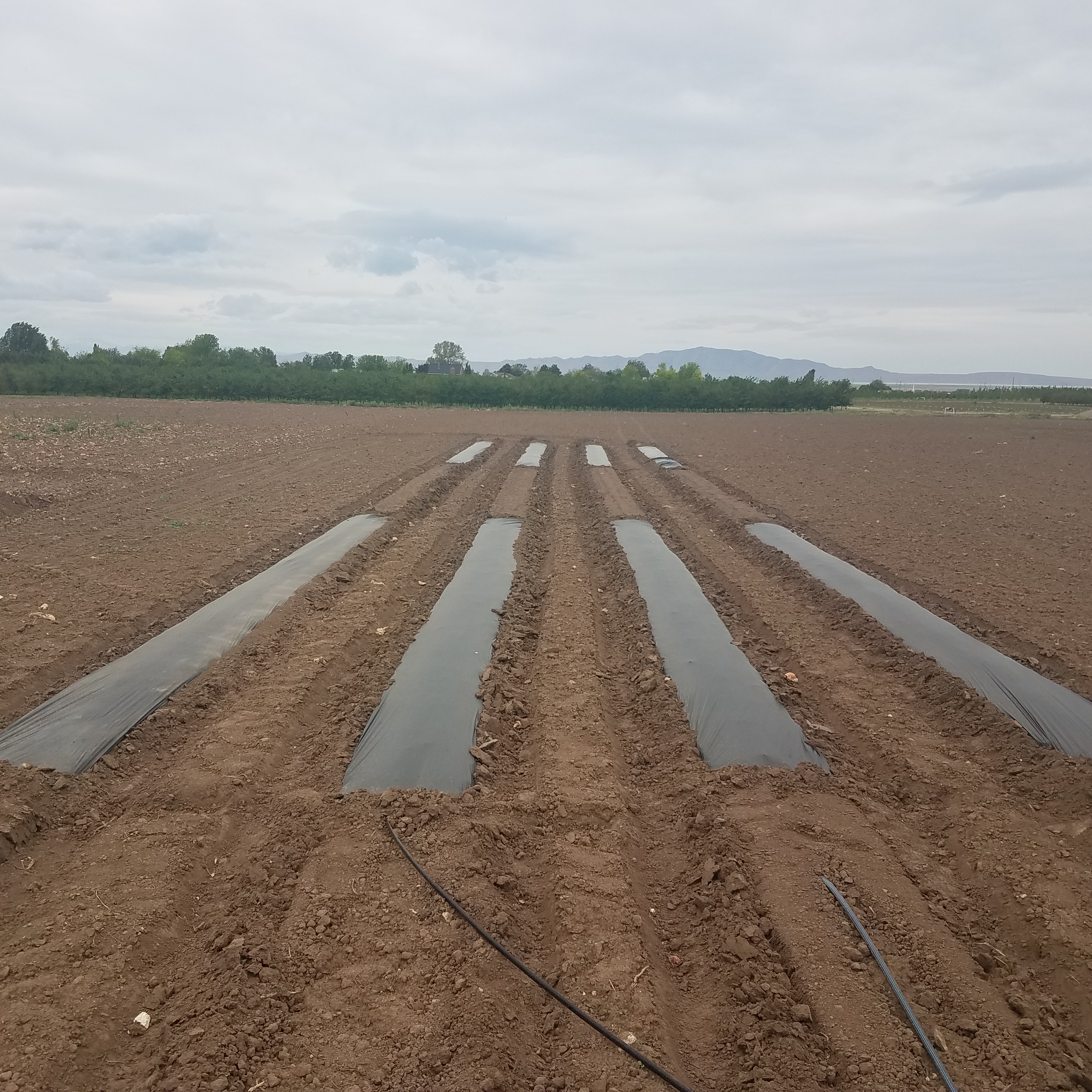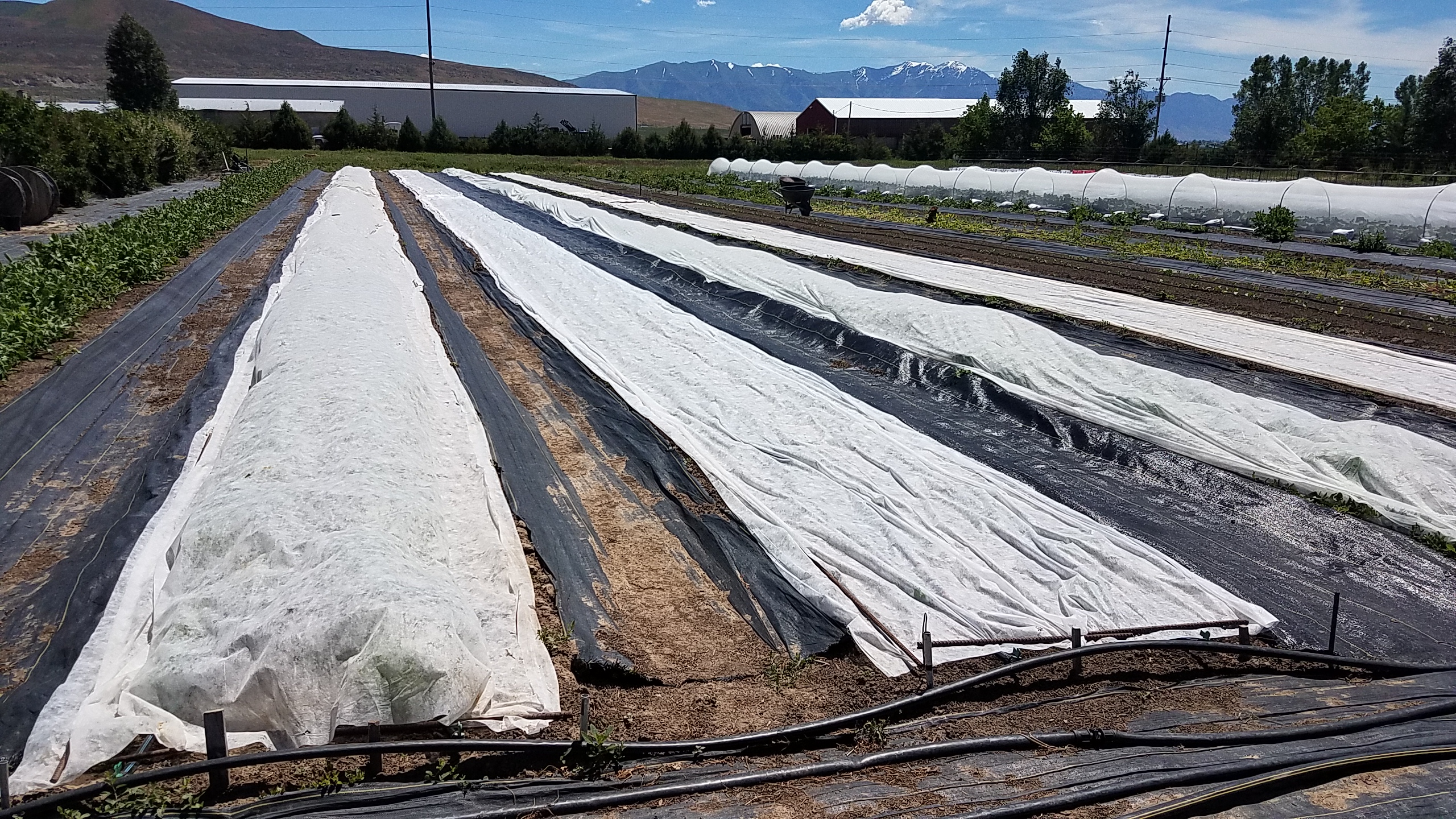Mulches and Row Covers
Mulch is any material (natural or artificial) that is used to cover the surface of the soil and modify the soil environment. Natural mulches include bark, wood chips, straw, manure, compost, or sawdust. Artificial or synthetic mulches include plastics, paper, or foils. Row covers are materials that cover plants and create an altered environment around them.
The advantage associated with mulches and row covers is to create conditions that improve the growth of the crop. Some of the more common benefits of mulches and row covers are significant temperature modification, more efficient water use, reduced fertilizer losses, improved weed and insect management, and reduced fruit losses due to rots.
Mulches
The most popular mulches used in agriculture are clear and black polyethylene (plastic) films. Clear plastic is used where higher soil temperatures are needed early in the season for crops like cucumbers, melons, and sweet corn. Soil temperatures are generally 10°F warmer under clear than black plastic and 15-20°F warmer than bare soil. This extra warmth usually results in high yields for early spring-planted crops. One disadvantage associated with clear plastic is the need for good weed control under the mulch. Often, soil fumigation is used in conjunction with clear plastic to better manage weeds, diseases, and insects.
There are many different mulch colors and compositions available for use. Black is the most common color, but there are instances where green 'IRT' mulches are used where soil temperatures need to be warmer. Silver or aluminized mulches have been shown to repel certain insect pests (aphids, thrips). In cloudy areas, red mulches reflect more light back into the plants which increases productivity. In the heat of summer, white mulches reflect heat and soils stay cooler. Regardless of the mulch color, to obtain the soil temperature benefits, lay the mulch 3 to 6 days before planting. If you fumigate under clear mulch, allow 21 days for fumigants to dissipate before planting.
In a typical mulching operation, a 3- or 4-foot-wide mulch plus drip irrigation tape are laid at the same time. Mulches will work with furrow irrigation so long as furrows and plants are very close to the plastic edge so young plants can access the water.
Other options are photodegradable and biodegradable plastic mulches. These usually cost more than regular plastic films but the difference may be offset by reduced disposal costs. Over time, sunlight causes photodegradable mulches to become brittle and break down. One disadvantage of the degradable mulches is that small pieces of film tear off and are blown around by the wind. In addition, they are weakened by soil microorganisms in high soil moisture and temperatures. One advantage is that they can be incorporated into the soil at the end of the growing season.
 Plastic mulches are commonly only used once, then are removed from the field and disposed at the end of the growing season. On small farms it is often removed by hand while on larger operations, tractormounted mulch removal equipment is available. Highquality plastic mulches can be used for two successive crops during the same season if you are careful. Crop foliage and weeds may increase the difficulty of mulch removal. When replanting through or removing the plastic mulch, eliminate as much vegetation as possible. Use glyphosate or paraquat to desiccate both weeds and residual crops or delay plant removal until after a hard frost kills the crop.
Plastic mulches are commonly only used once, then are removed from the field and disposed at the end of the growing season. On small farms it is often removed by hand while on larger operations, tractormounted mulch removal equipment is available. Highquality plastic mulches can be used for two successive crops during the same season if you are careful. Crop foliage and weeds may increase the difficulty of mulch removal. When replanting through or removing the plastic mulch, eliminate as much vegetation as possible. Use glyphosate or paraquat to desiccate both weeds and residual crops or delay plant removal until after a hard frost kills the crop.
After the mulch has been removed from the field, dispose of used plastic in an environmentally appropriate manner. Regulations on disposal vary, so contact your local solid waste authority for recommended methods of disposal. Some plastics can be recycled and specific programs for recycling agricultural plastics may be available. Consult with your state authorities to learn the specifics of plastics disposal.
Organic mulches (straw, sawdust, bark, etc.) reduce soil temperatures, improve soil moisture control, and help reduce soil erosion (wind or water). If the organic mulch is applied thickly (>2 inches), good weed control is reported. Organic mulches are often bulky, hard to apply, and may be difficult to source. There have been instances where insect (slugs, cutworms, etc.) and rodent damage occurs when using organic mulches. Organic wind breaks are commonly used to provide plant protection during establishment and can be used with plastic mulches.
Row Covers
 Row covers are fabric or plastic materials which cover plants and hasten crop maturity, provide frost or hail protection, and also may exclude certain insect pests from gaining access to the crop. Floating row covers are made of lightweight spun fibers (polyester or polypropylene) that lay loosely on the plants or can be suspended over the plants with wire supports.
Row covers are fabric or plastic materials which cover plants and hasten crop maturity, provide frost or hail protection, and also may exclude certain insect pests from gaining access to the crop. Floating row covers are made of lightweight spun fibers (polyester or polypropylene) that lay loosely on the plants or can be suspended over the plants with wire supports.
Floating row covers are used to cover low growing vine crops or to protect upright plants like tomatoes and peppers. Plants may be injured by abrasion when the floating row cover rubs on the plant in windy conditions. Frost damage can occur with floating row covers, particularly where the covers touch the leaves. Air temperature under the floating row cover is 3-5°F warmer at night, and more than 10°F higher during the day than the outside air temperature.
Clear and translucent plastic row covers (low tunnels) are another option to enhance early season plant growth. Plastic row covers are supported by wire hoops placed at 3 to 6 foot intervals in the row. Air temperatures under the low tunnels on warm sunny days can be 25-30°F warmer than outside, so plants may experience heat injury. Provided the temperatures under the low tunnels do not exceed 90°F, most warm season crops are not damaged. At higher temperatures, crops can be stressed, which inhibits growth, causes flower abortion or bolting.
Fabric and plastic row covers are often used in combination with plastic mulches. Most research shows that plants grown on plastic mulches under row covers mature earlier and yield more than those grown outside on bare ground. Several different companies make equipment that lay plastic mulch and row covers in one operation. Plastic mulches, fabric, and plastic row covers can be costly, and prices change rapidly because they are manufactured from petroleum. Consult your dealer for current prices.
More Information
- Using Mulches in Utah Landscapes and Gardens (Utah State University Extension)
- Use of Plastic Mulch for Vegetable Production (Utah State University Extension)
- Row Covers (Utah State University Extension)
- Low Tunnels: A Lot-Cost Protected Cultivation Option (Utah State University Extension)
How to Make Row Covers
How to Extend the Growing Season

